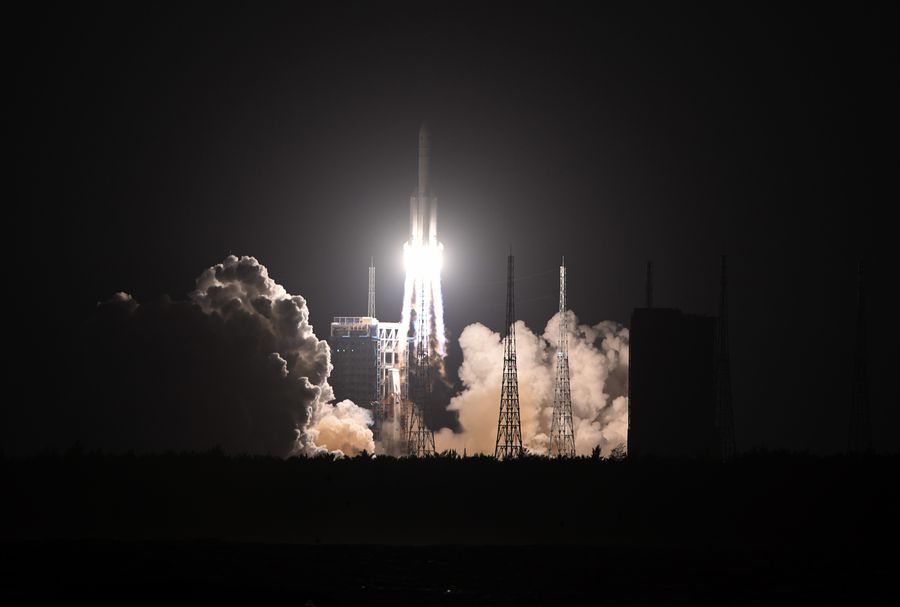
Long March-5 Y3 blasts off from Wenchang Space Launch Center in south China's Hainan Province, Dec. 27, 2019.(Xinhua/Yang Guanyu)
China successfully launched the third Long March-5, the largest carrier rocket of the country on Friday. It lays the foundation for a series of future space projects including exploring Mars, returning moon samples and constructing China's own space station.
by Xinhua Writers Yu Fei, Quan Xiaoshu
WENCHANG, Hainan, Dec. 27 (Xinhua) -- China launched the third Long March-5, the largest carrier rocket of the country, from Wenchang Space Launch Center in south China's Hainan Province on Friday evening.
The rocket, coded as Long March-5 Y3, blasted off from the coastal launch center at 8:45 p.m. (Beijing time), carrying the Shijian-20 technological experiment satellite weighing over eight tonnes, the heaviest and most advanced communications satellite of the country.
About 2,220 seconds later, the satellite was sent into its planned orbit.
Wu Yanhua, deputy director of the China National Space Administration (CNSA), declared the launch a success.

Carrier rocket Long March-5 Y3 is seen at the Wenchang Space Launch Center in south China's Hainan Province, Dec. 21, 2019.(Zhang Gaoxiang/Xinhua)
The success of the flight lays the foundation for a series of future space projects for the country including exploring Mars, returning moon samples and constructing its own space station, Wu said.
The Shijian-20 satellite will be used to test the key technologies of the DFH-5 platform, China's new-generation large satellite platform, and offer communication and broadcasting service, Wu said.
The Long March-5 is a large, two-stage rocket, capable of carrying a payload of 25 tonnes, equivalent to the weight of 16 cars, to low Earth orbit, 14 tonnes to geostationary transfer orbit, eight tonnes to Earth-Moon transfer orbit, or five tonnes to Earth-Mars transfer orbit, over twice the capacity of the current main Long March series rockets. Combined with an upper stage, the rocket is capable of sending probes to explore Jupiter and other planets in the solar system, according to the China Aerospace Science and Technology Corporation (CASC).
The Long March-5 made its maiden flight on Nov. 3, 2016 from Wenchang. However, the second large rocket, Long March-5 Y2, suffered a failure, as a malfunction happened less than six minutes after its liftoff on July 2, 2017.
The research team has found that the failure was caused by a problem in the engine of the first core stage of the rocket. "We have made improvements to the design, materials and technologies of the engine," said Li Dong, chief designer of the Long March-5 rocket from the China Academy of Launch Vehicle Technology (CALT) under the CASC.
Compared with the Long March-5 Y2, the new rocket has more than 200 technological improvements, said Yang Hujun, deputy chief designer of the rocket.
The modified engine has undergone more than 10 ground tests lasting over 3,000 seconds in total.
"Over the past two years, the research team has solved the problem of the engine and improved the reliability of the rocket," said Wang Jue, chief commander of the research team.
The carrying capacity of the Long March-5 rocket equals that of other mainstream large-scale rockets in the global industry, greatly improving China's ability to launch spacecraft and laying the foundation for developing new-generation carrier rockets and heavy-lift launch vehicles, said Wang Xiaojun, head of the CALT.
The rocket is about 57 meters long, equivalent to the height of a 20-story building, with a 5-meter diameter core stage and four 3.35-meter diameter boosters. The Long March-5 is much larger than China's previous carrier rockets. It has a takeoff weight of about 870 tonnes and a thrust of over 1,000 tonnes.
The four boosters, developed by the Shanghai Academy of Spaceflight Technology under the CASC, shoulder over 90 percent of the takeoff thrust.
The rocket uses environmentally friendly fuel, including kerosene, liquid hydrogen and liquid oxygen, rather than highly toxic propellants.
It is equipped with eight liquid oxygen/kerosene rocket engines in four strap-on boosters, two liquid hydrogen/liquid oxygen engines in the first stage and two relatively small liquid hydrogen/liquid oxygen engines in the second stage.
The weight of the rocket itself only accounts for about 10 percent of the liftoff weight, and the other 90 percent is the weight of the propellants.
The research team has made efforts to decrease the weight of the rocket in its design. For instance, the thickness of the rocket shell in some parts is only a few millimeters, according to Li Linsheng, a structural strength analysis designer of the rocket.
The temperature of liquid hydrogen is minus 253 degrees centigrade, and the temperature of liquid oxygen is minus 173 degrees centigrade. The maximum temperature of the fuel during combustion in the rocket engine is more than 3,300 degrees centigrade.
China built the Wenchang Space Launch Center, the country's fourth space launch center, for the Long March-5 and other new-generation carrier rockets. The center is located on the coast of the tropical island province of Hainan, which avoids possible damage caused by the falling rocket remnants.
In the center is the country's largest and most advanced launch pad that is 70 meters tall, equivalent to the height of a 24-story building, and covers an area of 600 square meters, the same size as half a basketball court. ■



